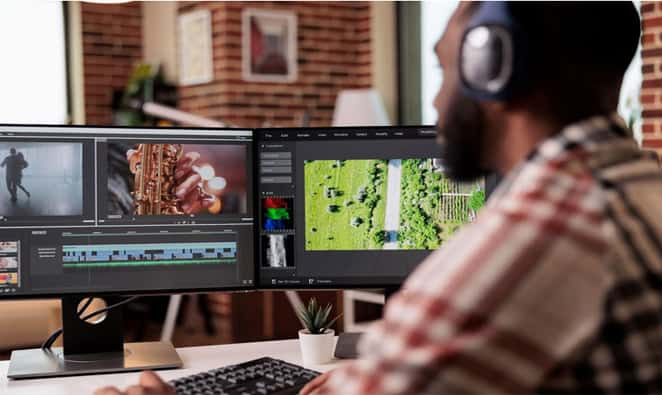
Video editing can feel like an overwhelming skill to learn, especially when you’re just starting out. But with the right approach, you’ll find that working with your footage is more intuitive than it seems.
In this guide, we’ll cover the basics of video editing, essential editing techniques, and practical video editing tips to help you develop a workflow that saves time while improving the quality of your final product.
Video Editing Basics for Beginners
Before diving into advanced tricks, it’s important to grasp the fundamental elements of video editing. Here are some of the core concepts every beginner should know:
Choosing the Right Video Editing Software
There are plenty of editing tools available, from simple free options to high-end professional suites. For beginners, we recommend software with a user-friendly interface and a number of built-in presets that will make the editing process faster and easier. And don’t forget about all the essential features for cutting, merging, and enhancing videos, of course.
Additionally, if you’re not scared of difficulties, you may try out some advanced software that offers more detailed control over edits. If you plan to pursue video editing more seriously, investing time in learning these tools can be beneficial.
Understanding the Timeline
The timeline is where all the action happens. This is where you place, cut, and organize your clips. Get comfortable dragging and dropping footage, adjusting sequences, and layering different elements such as text and music. Understanding how to navigate and manipulate the timeline efficiently will significantly improve your editing speed.
File Formats and Resolution
Before you start editing, it’s important to make sure your footage is in a compatible format and resolution. Most editors support common formats like MP4, MOV, and AVI. For the best results, always work with high-resolution files that maintain quality after export.
Additionally, understanding the difference between frame rates (24fps, 30fps, 60fps) and resolutions (1080p, 4K) will help you tailor your edits to the right platform. Social media platforms have different requirements for video resolution and aspect ratios, so be sure to check before exporting your final project.
How to Edit Videos: 10 Tips for Beginners
Once you understand the basics, it’s time to dive into some useful video editing tips that will help you create better videos faster.
1. Trim Unnecessary Footage
One of the most important editing techniques is learning to cut out unnecessary parts of your video. Remove long pauses, filler words, and any sections that don’t contribute to the story. A quick trim can make a big difference in keeping your audience engaged.
A well-edited video hooks the audience and keeps the pacing smooth and dynamic. A slow, choppy video can easily bore viewers, leading to lower engagement rates.
2. Use Smooth Transitions
Jump cuts can feel abrupt and disorienting if overused. Instead, experiment with basic transitions like fades, cross-dissolves, and wipes to create a seamless viewing experience. Just be careful not to overdo it — sometimes, simplicity works best.
Adding transitions between scenes can also help set the tone of the video. A fade-to-black transition may indicate the end of a chapter, while a cross-dissolve might suggest a gentle passage of time.
3. Balance Your Audio
Poor audio can ruin even the most visually stunning video. Make sure your background music isn’t drowning out your dialogue, and use noise reduction tools to eliminate unwanted background sounds. Always preview your video with headphones for best sound quality.
Audio balance also involves matching the audio levels across different clips. Consistency is key to making your video feel professional. Tools like equalization, compression, and normalization can help achieve this.
4. Merge Clips Smartly
Multiple clips should flow naturally. Use your editing software features to merge video files smartly and try to stitch clips together without awkward jumps. Pay attention to lighting and color consistency across clips for a better result.
Additionally, using J-cuts and L-cuts can help improve transitions between clips by overlapping the audio from one scene into the next. This technique creates a seamless flow that keeps the viewer engaged.
5. Add Text and Graphics Wisely
Titles, captions, and graphics can enhance a video, but too much text can be distracting. Keep text minimal and readable, and use colors that contrast well with your footage.
Subtitles are particularly useful for accessibility and for viewers who watch videos without sound. Many editing software options allow you to auto-generate captions, making the process easier.
6. Color Correction and Grading
Even a basic color adjustment can make your video look more professional. Many video editing tools include color correction features that allow you to adjust brightness, contrast, and saturation to give your footage a polished look.
If you’re aiming for a cinematic feel, color grading can help set the mood. Many editing programs offer LUTs (Lookup Tables) that apply preset color schemes to your footage for a more cohesive appearance.
7. Work with Keyboard Shortcuts
If you want to quickly speed up your editing process, learn your software’s keyboard shortcuts. This can significantly cut down the time you spend navigating menus and performing repetitive tasks.
Shortcuts for cutting, trimming, zooming in and out, and toggling between editing tools can save you hours in the long run.
8. Use B-Roll Footage
B-roll refers to supplementary footage that can help enhance your main content. It can be anything from close-up shots to scenery that adds depth to your video. This technique makes transitions feel more natural.
Using B-roll is especially effective in storytelling, helping to illustrate a point or provide a visual break from talking-head shots.
9. Keep an Eye on Video Length
If your video drags on too long, you risk losing your audience. Keep it concise and engaging, only including what’s necessary to convey your message.
Different platforms have different ideal video lengths. A regular YouTube video (not a Short) may perform well at 10–15 minutes, while an Instagram Reel should be under 60 seconds. Understanding these limits will help you tailor your content accordingly.
10. Export in the Right Format
Once you’re satisfied with your edits, it’s time to export. Choose a format that balances quality and file size. MP4 is a widely used format that provides the best compatibility across different devices and platforms.
Additionally, be mindful of compression settings. Too much compression can degrade video quality, while a file that’s too large may be difficult to upload.
The Bottom Line
Mastering video editing for beginners requires patience and practice, but with the right approach, you’ll be creating high-quality videos in no time.
By focusing on basic principles, improving your editing techniques, and using smart shortcuts, you can drastically improve the quality of your content. Keep experimenting, stay creative, and soon, editing will feel second nature to you!




